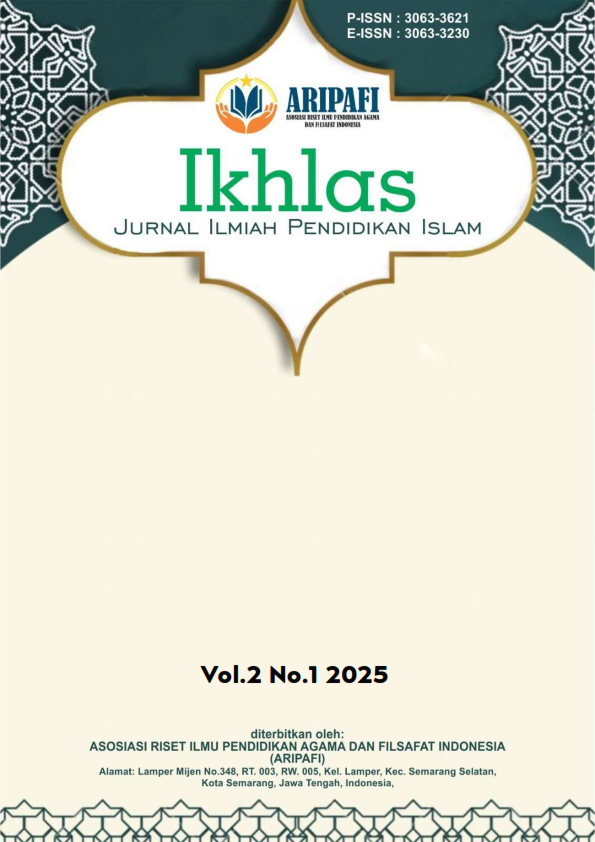Perspektif Tafsir dari Segi Bentuknya
DOI:
https://doi.org/10.61132/ikhlas.v2i1.356Keywords:
Tafsir bi al Matsur, bi al Ra'yi, al IsyariAbstract
The Qur'an, as the guiding book for Muslims, contains profound meanings that have consistently attracted scholarly attention throughout history. To comprehend these meanings, various interpretive methods have been developed and categorized based on their forms: Tafsir bi al-Matsur, Tafsir bi al-Ra’yi, and Tafsir bi al-Isyari. This article explores the characteristics, methods, and contributions of each type of interpretation in understanding the Qur'an. Tafsir bi al-Matsur relies on the traditions of the Prophet, his companions, and successors, providing an authoritative foundation. Tafsir bi al-Ra’yi integrates reason and ijtihad to address contemporary challenges. Meanwhile, Tafsir bi al-Isyari emphasizes esoteric dimensions that are symbolic and spiritual in nature. This study reveals that these three forms of tafsir complement each other in bridging human understanding of the Qur'an and addressing the intellectual and spiritual needs of Muslims in various life contexts.
References
Achmadin, B. Z., Fattah, A., Asrori, M., & Mukhsin, A. (2024). Model of tafsir bi al-ma’tsur approach relevance to islamic education: a chronological review of qur’anic interpretation. At-Turats Journal Is a Journal of Islamic Education, 18(4), 54–73.
Akhyar, M., Junaidi, J., Supriadi, S., Febriani, S., & Gusli, R. A. (2024). Implementasi Kepemimpinan Guru PAI dalam Meningkatkan Motivasi Belajar Siswa Melalui Pemanfaatan Teknologi di Era Digital. Al Qalam: Jurnal Ilmiah Keagamaan Dan Kemasyarakatan, 18(6), 4234–4248.
Akhyar, M., & Samad, D. (2024). STUDI ANALISIS TAFSIR AL-QUR’AN DAN RELEVANSINYA DALAM PENDIDIKAN ISLAM. INOVATIF: Jurnal Penelitian Pendidikan, Agama, Dan Kebudayaan, 10(1), 38–57.
Arif, M. S. (2021). TAFSIR BI AL-ISYARAH. ’Aainul Haq: Jurnal Hukum Keluarga Islam, 1(II).
Arsad, M. (2018). PENDEKATAN DALAM TAFSIR (Tafsir Bi Al Matsur, Tafsir Bi Al Rayi, Tafsir Bi Al Isyari). Yurisprudentia: Jurnal Hukum Ekonomi, 4(2), 147–165.
Baihaqi, N. N. (2022). KARAKTERISTIK TAFSIR RUH AL-MA’ANI. Al Muhafidz: Jurnal Ilmu Al-Qur’an Dan Tafsir, 2(2), 115–130.
Firdaus, M. Y., Malik, N. H. A., Salsabila, H., Zulaiha, E., & Yunus, B. M. (2023). Diskursus Tafsir bi al-Ma’tsur. Jurnal Dirosah Islamiyah, 5(1), 71–77.
Maulana, M. (2020). Perkembangan Tafsir Timur Tengah Zaman Nabi Sampai Kontemporer. JURNAL ILMIAH FALSAFAH: Jurnal Kajian Filsafat, Teologi Dan Humaniora, 6(2), 118–138.
Nurman, M. (2023). Legalitas Tafsir Isyari dalam Penafsiran Al-Quran. ISME: Journal of Islamic Studies and Multidisciplinary Research, 1(1), 1–6.
Supratman, J. (2014). Pendekatan penanfisran al-Qur’an yang didasarkan pada instrumen riwayat, nalar, dan isyarat batin. Intizar, 20(1), 43–62.
Ushama, T., & Basri, H. (2000). Metodologi Tafsir Al-Quran: Kajian Kritis Objektif dan Komprehensif.
Wahid, A. (2010). Tafsir Isyari dalam Pandangan Imam Ghazali. Jurnal Ushuluddin, 16(2), 123–135.






